The game has changed. Old ways of telling people about your product? They’re fading. Today, attention is the real currency. You need to earn it. People don’t just buy stuff. They’re buying into stories, values, and experiences. And they’re doing it on their terms.
Consider this: Over 67.9% of the world’s population uses social media, or 5.56 billion people. TikTok, for example, is the most downloaded non-gaming app globally. Short-form video is the most popular content format marketers use, beating out images and blog posts. In 2024, 82% of people said watching a video influenced their purchase decision.
This isn’t about shouting louder. It’s about speaking smarter. It’s about understanding how the world communicates now. And then doing it better.
What is Marketing Communication?
Marketing communication is how a business talks to its market. Simple. It’s the messages and the methods used to connect with potential buyers. Think of it as your brand’s voice. It tells people who you are, what you offer, and why it matters.
It’s not just advertising. It’s every touchpoint. Every touchpoint matters. From a tweet to an email. It’s about creating a clear, consistent conversation. The goal? To get people to know you, like you, and trust you enough to buy from you. And then to keep buying.
Objectives of Marketing Communications
Why do businesses bother with all this talking? It’s not just to make noise. There are clear goals behind every message. First, get seen. No one buys a ghost. New brand? Get your name everywhere.
Next, it’s about creating interest. Awareness isn’t enough. You need to make people curious. Show them something new, something that solves a problem they have.
Then comes desire. This is where you make them want it. You show the benefits. You paint a picture of how their life gets better with what you offer.
Finally, action. This is the sale. Getting them to click the buy button, call you, or walk into your store. But it doesn’t stop there. Good communication also keeps customers around. It builds loyalty. It turns buyers into advocates. It makes them tell their friends. It shortens the sales cycle.
Types of Marketing Communications
There are many ways a business speaks. Each has its rhythm and purpose.
1. Advertising
This is the big one. What most people think of when they hear “marketing.” It’s paid messages designed to reach a large audience. Think TV commercials, online ads, billboards, and radio spots. It’s about getting your message out there, fast. You control the message completely. It builds brand awareness and makes people remember your name.
2. Public Relations (PR)
PR is about managing your reputation. It’s getting media coverage without paying for it directly. This means press releases, media events, and crisis management. When a newspaper writes a positive story about your company, that’s PR. It builds credibility and trust. People often trust a news story more than an ad.
3. Sales Promotion
These are short-term offers to get people to buy now. Discounts, coupons, contests, loyalty programs. “Buy one, get one free.” “20% off this weekend.” It creates urgency. It’s for immediate sales boosts. It moves inventory.
4. Direct Marketing
This is personal. Messages sent right to an individual. Email campaigns, direct mail, SMS messages. The idea is to tailor the message. Talk to people, not crowds. Speak to them, based on what you know. It aims for a direct response. Think of an email with a personalized offer.
5. Digital Marketing
This is the online world. Websites, social media, search engine optimization (SEO), paid online ads, and email marketing. It’s showing up where everyone already is. It’s measurable. You see what works. You can adjust quickly. Over 32.9% of internet users aged 16+ find new brands through search engines. Being visible online is non-negotiable.
6. Content Marketing
Creating valuable stuff. Blogs, videos, infographics, and podcasts. Not directly selling, but giving information or entertainment. It builds authority. This creates trust. It draws people in over time. For example, a software company offering free webinars to explain how their product helps users.
7. Personal Selling
Face-to-face interaction. Salespeople are talking directly with potential customers. This is highly persuasive. It builds relationships. It allows for immediate feedback. Think of a car salesperson or a B2B sales rep. They answer questions on the spot.
How to Create a Marketing Communications Strategy?
You don’t just throw messages out there. You need a plan. A strategy.
1. Define Your Target Audience
Who are you talking to? You can’t speak to everyone. Trying to speak to no one. Understand their age, interests, problems, and where they spend their time. This shapes your message. It tells you where to put it.
2. Set Clear Objectives
What do you want to achieve? Be specific. “Increase brand awareness by 20% in six months.” “Generate 500 new leads this quarter.” Measurable goals. If you don’t know where you’re going, any road will do. But it won’t be the one.
3. Craft Your Key Messages
What do you want to say? Your core idea. What makes you different? Why should anyone care? Keep it simple. Make it memorable. It needs to be consistent across all your channels.
4. Choose Your Channels
Where will you send your messages? Based on your audience, pick the platforms. Is it social media? Email? Billboards? A mix? Different messages work on different channels. A short video for TikTok, a detailed article for your blog.
5. Create & Distribute Content
Now, make the actual messages. Write the ad copy. Design the images. Shoot the videos. This is where your messages come alive. Make it good. Make it sticky.
Most people think creating content is enough. It’s not. If no one sees it, it doesn’t exist. That’s where content distribution agents come in. Their job? Get your message in front of the right eyes. On the right platforms. At the right time.
6. Implement and Monitor
Put your plan into action. Then watch what happens. Are people responding? Are you hitting your objectives? Use data. Google Analytics shows website traffic. Social media insights show engagement. Over 41% of marketers measure content marketing success through sales.
7. Measure and Adapt
Look at the data. What worked? What didn’t? Tweak your strategy. Don’t be afraid to change. The market moves fast. You need to move faster. This isn’t a one-and-done deal. It’s a continuous process.
Best Marketing Communication Tools and Software
You need the right tools for the job. These tools make communication smoother, faster, and better.
CRM (Customer Relationship Management) Software
This is your customer hub. It stores all customer info. Helps you manage interactions. Think of tools like HubSpot or Salesforce. They let you track leads, manage customer data, and personalize communication. HubSpot, for example, combines marketing, sales, and customer service.
1. HubSpot CRM

HubSpot CRM. What is it? It’s your business’s core for growth. More than just software, it brings together marketing, sales, and service. All of it runs on AI. Think of it as the main system for customer connections.
Why Choose HubSpot CRM?
Why pick HubSpot? It’s simple. Most businesses use many separate tools. Sales is one place, marketing another, and customer service is on its own. HubSpot fixes this mess. It puts everything together. You get a clear, full view of every customer. This is more than just managing contacts. It’s about building a smooth, automated customer journey.
And here’s the best part: they give you a free CRM that works. Get in, start using it, and grow. No big upfront cost, no hard learning. Just pure chance for growth.
Standout Features
What makes HubSpot special? It’s AI. “Breeze Agents,” do your boring tasks. They write content, find leads, and answer customer questions. They also made a visual Data Model Builder. This lets you shape your CRM to your exact needs. And the automation? It’s top-notch. Drag-and-drop tools for emails, landing pages, and forms. You don’t need to code, just create.
Integrations
They have over 1500 connections. Stripe for payments, Mailchimp for emails, even your Gmail and Outlook. HubSpot isn’t closed off. It’s a central point in a large digital system.
Latest Advancements
HubSpot isn’t standing still. They are putting a lot into AI. Smarter AI agents for support and finding new customers. AI-powered reports that actually tell you something helpful. And data. They care deeply about data being correct, with automatic formatting and a visual Data Model Builder. Over 200 new features came out recently. This is more than just an update; it’s a big step forward.
Pros:
- A free plan is strong.
- Easy to use, all-in-one system.
- Very good AI and automation.
Cons:
- It can get costly as you grow.
- Customization has limits for complex needs.
- Some specific features aren’t as deep as separate tools.
Pricing
You can start for free. No excuses. If you need more, paid plans for individual parts start around $20 per month per user.
G2 User Rating – 4.4 out of 5 stars (based on HubSpot Sales Hub reviews)
2. Salesforce

Salesforce CRM. It’s your hub for customer relations. This is a big cloud platform. It links sales, service, and marketing. It’s known for being a system that grows with your business.
Why Choose Salesforce CRM
Why pick Salesforce? Most businesses have scattered customer data. Salesforce fixes this. It gives you one shared view of every customer. Every interaction is tied together. This means sales, service, and marketing work from the same plan. No blind spots.
Salesforce is also known for how much you can change it. You can make it do what you want. Need specific workflows, special reports, or complex automated tasks? Salesforce handles it. It’s built for growing businesses. It has the power to support your goals.
Standout Features
What makes Salesforce special? Its deep customization options are a big part. You can adjust dashboards, reports, and workflows to fit your exact processes. And its AI, Einstein, is strong. It predicts results, scores leads, and gives smart insights that cut through extra noise.
Integrations
Salesforce lives in a connected space. Its AppExchange has thousands of apps. It connects to everything: marketing tools, payment systems, and communication apps like Slack. It’s made to connect with what you already use.
Latest Advancements
Salesforce keeps moving forward. They are putting a lot into AI with “Agentforce.” These are AI agents that handle tough tasks. This includes making proposals and starting campaigns. They are also making Data Cloud more central. It uses real-time data for smarter insights and helps those AI features work.
Pros:
- Lots of ways to customize.
- Strong reporting and data tools.
- Grows well with any business size.
Cons:
- Can be hard to set up and use.
- Costs more than many other options.
- Some support experiences can be hit or miss.
Pricing
Salesforce does not have a free plan for its main CRM. Starter Suite plans begin at $25 per user per month.
G2 User Rating – 4.4 out of 5 stars (based on Salesforce Sales Cloud reviews)
Email Marketing Tools
Still king for direct contact. Automate campaigns. Send newsletters. Segment your audience. Mailchimp and ActiveCampaign are popular choices. Mailmodo offers interactive emails. These tools help you reach customers directly and affordably.
3. Mailchimp
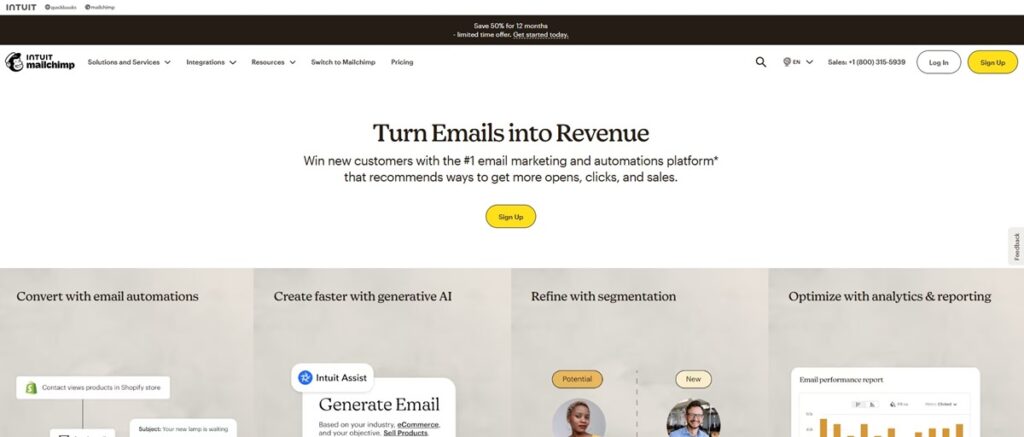
Mailchimp helps businesses with email and marketing. It’s known for being easy to use. It manages email campaigns well. Millions use it to talk to their customers.
Why Choose Mailchimp?
Pick Mailchimp because it makes hard things simple. It’s a full digital marketing platform. It started with email, now it has many tools. The big plus? It’s easy to grasp. Even new marketers can use it.
Mailchimp stands out. It brings together many marketing tools. From emails to landing pages and social media ads. It guides you. You can focus on your message, not the tech.
Standout Features
Mailchimp has a drag-and-drop email builder. It has smart automation for customer journeys. And strong ways to split your audience. These tools help you send the right messages. They automate your outreach. This saves time and makes your messages more useful.
Integrations
It works with hundreds of tools you already use. Like Shopify, WordPress, Facebook, Google Sheets, Salesforce, and Zapier. This connection lets you share customer data. It makes e-commerce run smoother. It helps you reach more people across different platforms.
Latest Advancements
Mailchimp uses a lot of AI now. Expect smart groups that find your best customers. AI helps suggest content. And smart scheduling sends emails at the best time. It’s about using data to make campaigns work better.
Pros:
- Easy to use, even for new people.
- Great audience grouping and customer journey features.
- Connects well with many other tools.
Cons:
- Free plan has fewer features and less customer help.
- Costs can go up a lot as your contact list grows.
- Some advanced features, like detailed automation, take time to learn.
Pricing
Mailchimp has a free plan with basic features. Paid plans start around $15 a month for 500 contacts.
G2 User Rating – 4.3 out of 5 stars
4. ActiveCampaign
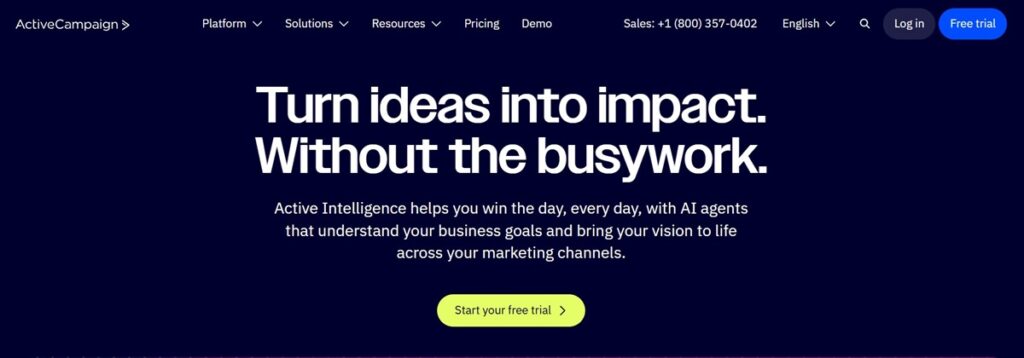
ActiveCampaign helps with marketing. It lets you create personal customer experiences. It’s known for its automation and built-in CRM. Businesses use it to connect better with their audience.
Why Choose ActiveCampaign?
Pick ActiveCampaign when you want more than just mass emails. You want to build customer relationships that lead to sales. ActiveCampaign gives you detailed control over who you talk to and how. Most other tools don’t offer this. Your marketing messages will hit the mark.
It brings together email marketing, automation, and sales CRM in one place. No more switching between apps. ActiveCampaign manages your whole customer journey. From the first contact to buying and coming back, it uses smart automation to help you.
Standout Features
Its best features include easy-to-use automation builders, detailed ways to group contacts, and a CRM. This CRM connects your sales and marketing. You can map out how customers move, score leads, and trigger actions based on what people do. Every message will be right for them.
Integrations
ActiveCampaign works with many other tools. It has hundreds of connections: Zapier, Shopify, Stripe, Calendly, Google Sheets, Typeform, and more. Your current apps can talk to ActiveCampaign. This makes data flow easily and opens up more automation options.
Latest Advancements
ActiveCampaign is using more AI. Recent updates include AI blocks in automation for things like feeling analysis and language translation. They also have SMS campaigns and Hilo for WhatsApp marketing. Plus, they are adding AI translations and a Goals Dashboard with AI insights.
Pros:
- Strong and flexible automation.
- Good ways to group contacts.
- Many connection options.
Cons:
- It can be hard for new users to learn.
- Price goes up quickly as contacts grows.
- The email editor can be tricky.
Pricing
ActiveCampaign has no free plan. But it offers a 14-day free trial. Paid plans start at $15 a month for 1,000 contacts.
G2 User Rating – 4.5 out of 5 stars
Social Media Management Platforms
Manage all your social channels from one place. Schedule posts. Track engagement. Hootsuite and Buffer are examples.
5. Hootsuite
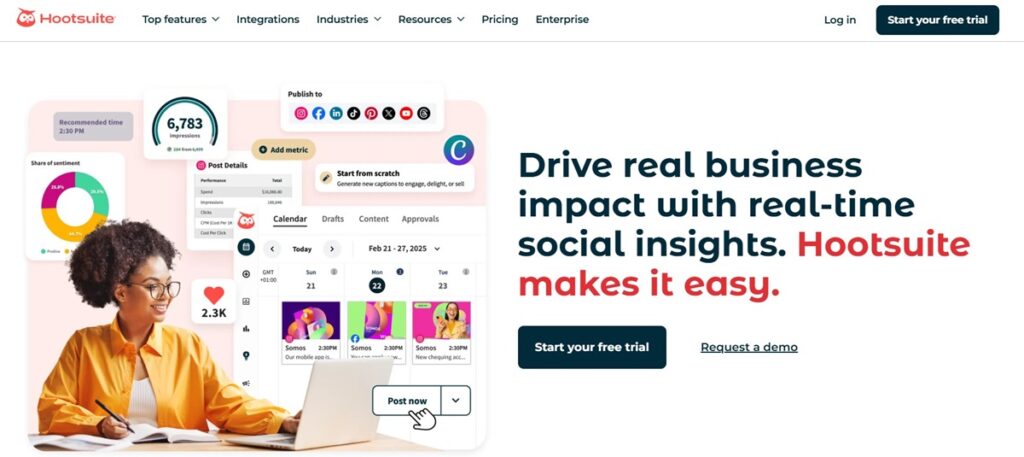
Hootsuite helps you manage social media. It brings your digital presence together. It’s known for scheduling, publishing, and real-time social engagement across many networks. This tool helps run your social media without the usual mess.
Why Choose Hootsuite?
You’re tired of too many tabs. Hootsuite fixes that. It puts all your social profiles in one place. Scheduling content, seeing data, and teamwork become easy. Stop jumping between platforms. Hootsuite gives you one control center.
It stands out because it works well with big social networks. It also has many features. From listening to social chatter to AI-made content. It’s not just a scheduler. It’s a full social media hub. It helps you lead in your area by showing you what your audience likes.
Standout Features
Hootsuite’s best features include “Streams.” These watch keywords and mentions in real time. It has a full content library. Its social media data goes beyond basic numbers. You can see how single posts did. Compared to competitors. Even get AI tips for the best times to post.
Integrations
The platform works with many tools. Think Facebook, Instagram, TikTok, LinkedIn, and YouTube. Also, content tools like Canva and Adobe Stock. It also links with CRM systems like Salesforce. It has add-ons for deep social listening and employee support. This makes it a very useful solution.
Latest Advancements
Hootsuite is always getting better. Recent updates let you post Facebook Stories and Reels directly. Its listening tools have a better AI Query builder for easy insights. TikTok sentiment analysis is better. They are also making things faster. Features like Smart Replies in the Advanced Inbox and new audiences for LinkedIn Ads help.
Pros:
- Manage many social media accounts from one place.
- Strong scheduling options.
- Detailed data and reports.
Cons:
- Costs more than some rivals.
- Some users find it hard to learn.
- Sometimes, the limits of what you can do directly on platforms.
Pricing
Hootsuite no longer has a free plan. But you can get a 30-day free trial. Paid plans start at $99 a month if you pay yearly.
G2 User Rating – 4.2 out of 5 stars
6. Buffer

Buffer helps you manage social media. It is known for easy scheduling. You can plan, post, and check content on many social sites from one simple place. Buffer makes it easy to keep your online presence steady.
Why Choose Buffer?
Buffer is simple and easy to use. Other tools have too many features. Buffer focuses on getting your content out well. Its clean look means less time learning. More time making an impact. It’s for those who want to be efficient, not deal with extra complexity.
Buffer is cheap and has strong main features. This makes it good for small businesses and creators. You get key scheduling, posting, and basic data without the high cost of big business tools. Also, it focuses on reliable content delivery. Your posts go out, always, without problems.
Standout Features
Buffer’s best features include a drag-and-drop calendar for visual scheduling. You can post directly to major platforms. An AI Assistant helps write and fix social media text. The “Start Page” feature lets you make a simple landing page, good for a link-in-bio.
Integrations
Buffer connects with important tools to do more. It works with Canva for easy image making. Shopify connects social data with sales info. Zapier links to thousands of other apps. This includes Google Sheets, WordPress, and Trello for wide workflow automation.
Latest Advancements
Buffer keeps getting better with AI. It has an AI Assistant to help create and make social media posts better. They are also improving their main scheduling system. They are adding direct posting to more social platforms. This helps users stay current.
Pros:
- Easy to use.
- Good prices.
- Reliable post scheduling and publishing.
Cons:
- Few advanced data features.
- Customer help is mainly by email.
- Lacks strong social listening tools.
Pricing
Buffer has a free plan. Paid plans start at $6 per channel per month (billed yearly).
G2 User Rating – 4.3 out of 5 stars
SEO Tools
Get found on Google. Research keywords. Analyze your website’s performance. SEMrush and Ahrefs are industry standards. Google Trends is free for seeing what people are searching for. These tools help you climb the search rankings.
7. SEMrush

SEMrush helps with online visibility. It’s known for keyword research, competitor checks, and site audits. It gives digital marketers the facts they need to do well in search results.
Why Choose SEMrush?
SEMrush is different. It shows all of digital marketing from one place. Other tools are specialized. SEMrush brings together SEO, content, PPC, and social media data. You get a full picture of your online work and your rivals’. This single view makes tough tasks easy. It helps you make smart choices based on data.
Its strength is giving you more than just data. It gives you clear ideas to act on. You see what competitors do well. You see where their traffic comes from. You also see the exact keywords that help them succeed. This rival information lets you improve your plans. You can build better campaigns. In the end, you can outrank the competition with smart moves.
Standout Features
SEMrush has strong features. Its Keyword Magic Tool finds billions of keywords and their meaning. Its Site Audit is like a doctor for your website. It finds technical SEO problems and tells you how to fix them. Backlink Analytics makes sense of links. It shows who links to whom and why. This helps you build site power. The SEO Writing Assistant makes writing content simple. It makes sure your words are good and search engine friendly.
Integrations
SEMrush links with key marketing platforms. This gives you a better, connected view. It works with Google Analytics and Google Search Console for live site data. It also connects with social media like Facebook, Instagram, Twitter, and LinkedIn. This lets you manage social media in one place.
Latest Advancements
SEMrush keeps adding new things with AI. New features include AI Optimization (AIO). This tracks and manages brand mentions in AI search engines like ChatGPT, Perplexity, and Gemini. ContentShake AI helps users write SEO-friendly articles. It even adds AI-made images. The platform also has AI suggestions for replying to Google Business Profile reviews.
Pros:
- A strong all-in-one tool for digital marketing.
- Great for keyword research and competitor checks.
- Easy to use with good reports.
Cons:
- It can feel big due to many features.
- It can be costly for small businesses.
- Traffic numbers can sometimes be too high and not match Google Analytics.
Pricing
SEMrush offers a free plan with some limits. Paid plans start at $139.95 each month.
G2 User Rating – 4.5 out of 5 stars
8. Ahrefs

Ahrefs is a top SEO tool. It’s known for strong backlink checks and keyword research. Marketers and SEO pros use it to see what rivals are doing and find new ways to rank.
Why Choose Ahrefs?
Stop guessing. Ahrefs gives you the data to win online. It checks billions of pages daily. This creates one of the biggest backlink lists. You get a clear view of competitor links. You see what it takes to beat them.
Other tools may try to do too much. Ahrefs stays focused on core SEO. Its deep data, especially for backlinks and keywords, means better ideas. You get smart insights to build winning SEO plans.
Standout Features
Ahrefs is great with its Site Explorer. It shows any website’s backlinks, traffic, and keywords. The Keywords Explorer gives you search volume and difficulty. It even pulls data from YouTube and Amazon. Plus, Site Audit finds technical SEO problems so you can fix them quickly.
Integrations
For reports, Ahrefs works with Looker Studio. This lets you put data into custom dashboards. It doesn’t focus on many other apps. Its main strength is giving direct, useful SEO data. You can get this through an API if you need to build custom workflows.
Latest Advancements
Ahrefs keeps getting better. Recent updates include AI ideas for content. There’s also instant keyword grouping for faster research. Better SERP comparison helps you see how search rules change. They also launched a program to help users master the platform.
Pros:
- Good and dependable backlink and keyword data.
- Easy to use with a clean look.
- Detailed reports and competitor checks.
Cons:
- Expensive, especially for small businesses.
- Hard for new users to learn.
- Some users report data can be off sometimes.
Pricing
Ahrefs has a free Webmaster Tools plan with limited access. Its paid plans begin at $99 a month for the Lite option (billed yearly).
G2 User Rating – 4.5 out of 5 stars
Content Creation Tools
Make visuals that grab attention. Canva is super easy for graphic design. Promo helps create quick videos. Good content stands out.
9. Canva
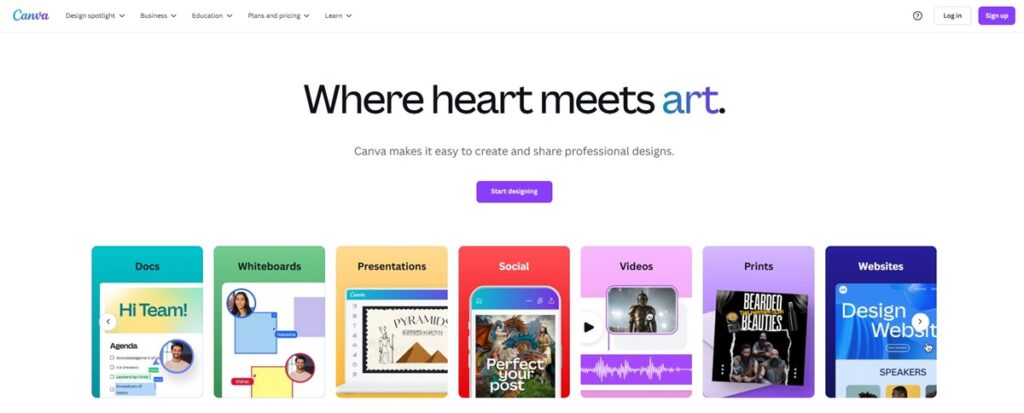
Canva helps you make visual content. It’s a design tool. It has an easy drag-and-drop system and many templates. Anyone can make great social media graphics, presentations, and marketing stuff easily.
Why Choose Canva?
Canva is clear. It makes design easy for everyone, not just pros. You get many ready-made templates and items. This gives you a quick start. You don’t begin with nothing. This is about making design quick and easy. You get your ideas out fast.
Lots of templates, from social posts to business cards, save you hours. Teams can work together in real-time. Everyone stays on the same page. Your creative work gets done faster. You get good results without hard learning or the high costs of old design software.
Standout Features
Canva’s “Magic Studio” has AI tools. Like Magic Grab for picking up objects. And Magic Resize to change designs for different sizes. The Brand Kit keeps your brand looking the same everywhere. Teams can work together live. Instant animation and a content planner also help. They are good for anyone making regular content.
Integrations
Canva works well with other tools. It connects with Google Sheets, Google Drive, Jotform, and Google Forms. This makes designing with data easy. It also links to social media tools like SocialBee. And automation tools like Zapier and Make. This helps you get your designs to your audience directly.
Latest Advancements
Canva’s new update, Visual Suite 2.0, brings a “One Design” way of working. You can build documents, presentations, and websites all in one place. This includes “Canva Sheets” for visual spreadsheets. And a better Photo Editor with AI, like click-and-edit and background making. AI features like Magic Write for custom text and Auto Trim for video editing have also been added.
Pros:
- Very easy to use.
- Lots of templates and items.
- Good teamwork features.
Cons:
- Less advanced features than pro design software.
- Some good features cost money.
- Needs internet for all features to work.
Pricing
Canva has a strong free plan. Its Pro plan for one person costs $12.99 a month or $119.99 a year.
G2 User Rating – 4.7 out of 5 stars
10. Promo.com
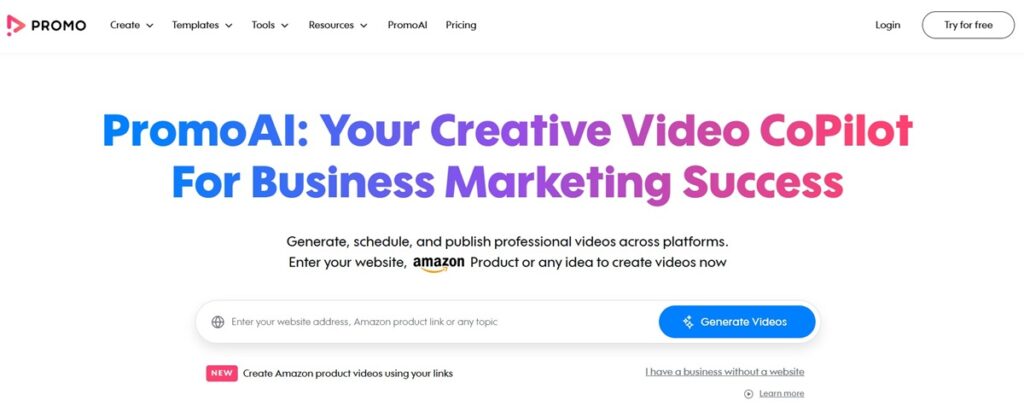
Promo.com makes videos online. It has a simple design and lots of stock media. It’s great for businesses, agencies, and people who need marketing videos fast. You can make high-quality videos for social media without much editing skill.
Why Choose Promo.com?
You don’t want to waste time. Promo.com understands that. It gives you direct access to millions of video clips and photos from places like Getty Images. It also has a big library of music you can use. This means no more searching for media or worrying about legal issues.
Other tools have templates, but Promo.com’s are made for quick results. They work well for social media and are easy to change. You’re not just making a video; you’re building a promotional item.
Standout Features
Promo.com has strong features. It has a simple drag-and-drop editor, custom branding for logos and watermarks, and animated text. It works with many video sizes for different social platforms. You can also export videos as GIFs or memes. This gives you many ways to create content.
Integrations
For easier work, Promo.com connects directly with social media sites like Facebook, Instagram, and YouTube. This makes publishing simple. You spend less time switching tools and more time getting your message out.
Latest Advancements
Promo.com keeps getting better, especially with AI. Their new PromoAI lets you make many unique videos for your business with one click. This cuts down on creation time a lot. Your content stays fresh and fitting.
Pros:
- Easy to use for beginners.
- Lots of stock footage and music.
- Quick video creation with templates.
Cons:
- Few advanced editing features.
- Higher-priced plans can be costly.
- Some templates need more ways to change them.
Pricing
You can sign up for Promo.com for free. This gives you access to its media and editing tools for drafts. Paid plans start at $59 per month for single creators.
G2 User Rating – 4.3 out of 5 stars
Analytics Tools
See what’s working and what’s not. Google Analytics gives deep insights into website traffic. Adobe Analytics offers real-time data for sales and marketing. You need to measure to improve.
11. Google Analytics 4 (GA4)

Google Analytics changes how we look at web data. It helps you see how people act on your websites and apps. It shows how they truly use your digital presence. GA4 is known for its event-based data. This gives you clear details about every action.
Why Choose Google Analytics 4?
Forget old methods. GA4 looks at events, not just sessions. This gives you a clear view of every scroll, click, and sale. It’s about seeing the whole customer journey. From their first visit to their final action, across all devices.
What makes GA4 good is its focus on privacy and predicting the future. It’s built for today’s internet. It offers better control over your data. It uses AI to guess what users will do next. This is more than just reports. It sets up your data for the future. You make better choices, quicker.
Standout Features
GA4’s best parts are its flexible event tracking, AI predictions, and custom reports. It measures things like scrolls and video plays automatically. It also lets you group audiences well. DebugView is great for fixing data issues.
Integrations
GA4 works well with other tools. It connects with Google Ads, Google Search Console, and BigQuery for deep data checks. Outside of Google, you can link it with HubSpot, Salesforce, Shopify, Mailchimp, and even ChatGPT. This happens through tools like Zapier. Your data moves across all your systems.
Latest Advancements
Recent GA4 updates focus on better AI insights. This includes better ways to spot odd data and see trends. It also holds data for longer. And it allows more custom event details. There’s a bigger focus on privacy. This means better Consent Mode hook-ups and more flexible ways to track how people find you.
Pros:
- A deeper look into user actions.
- Flexible event tracking.
- Combines data from different places.
Cons:
- Hard for new users to learn.
- An interface can be less clear than Universal Analytics.
- Setting up custom reports often needs technical skill.
Pricing
GA4 has a free version. It’s good for small to medium businesses. There’s a paid version, Google Analytics 360. It starts around $50,000 yearly for bigger companies.
G2 User Rating – 4.5 out of 5 stars
12. Adobe Analytics
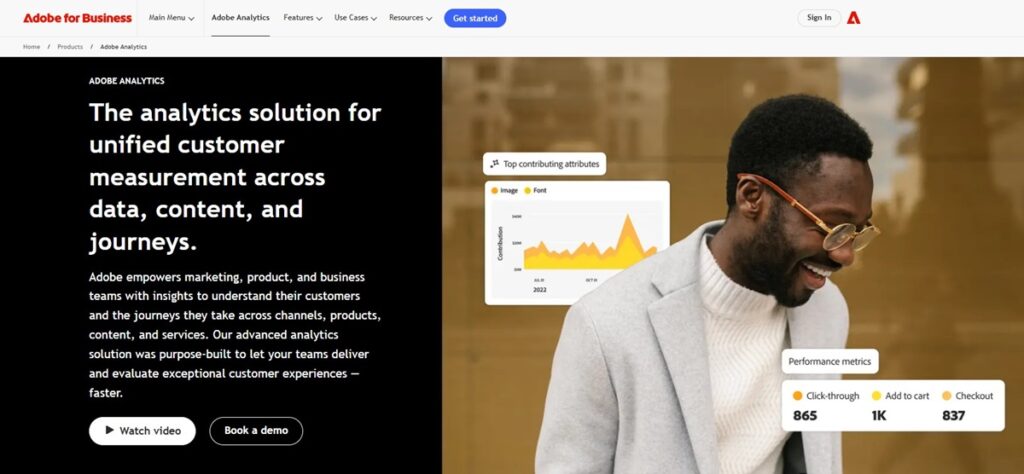
Adobe Analytics helps you understand what customers do online. It gathers lots of data. It gives custom, real-time reports for big companies.
Why Choose Adobe Analytics?
You want to know why customers act a certain way. Adobe Analytics gives you the full story. It offers great data control. You don’t just see what happened. You learn why, with deep control over your data that simpler tools can’t give.
This tool is for those who need exact details. If you need to join customer data from all places, online and off, Adobe Analytics gives you that view. It’s about seeing the whole picture, not just small parts.
Standout Features
Adobe Analytics shines with tools like Analysis Workspace for deep reports. It has advanced ways to group users. It also uses AI for smart predictions. It finds odd patterns and shows what caused them. This makes data analysis smart.
Integrations
It works well within the Adobe Experience Cloud. It links with Adobe Audience Manager, Adobe Target, Adobe Campaign, and Adobe Experience Manager. Outside of Adobe, it connects with many other tools, like Hootsuite and Invoca. This builds a full data system.
Latest Advancements
New updates focus on AI insights and better data rules. The Data Insights Agent, an AI helper, now answers questions in plain language. Connections with Microsoft 365 through the Adobe Marketing Agent bring analytics into daily business tools. There’s also a move to put certain data types only in the Data Warehouse. This makes Workspace work better and follow rules.
Pros:
- Customizable reports and groups.
- Deep analysis for complex data.
- Strong data security and privacy.
Cons:
- Hard to learn at first.
- Can be slow with lots of data or long timeframes.
- Expensive compared to some others.
Pricing
Adobe Analytics does not have a free plan. Prices are not public. It usually starts around $2,000 to $2,500 per month for small to medium businesses. Big companies can pay over $100,000 yearly.
G2 User Rating- 4.0 out of 5 stars
Project Management Software
Keep your team organized. Asana and Trello help manage tasks, deadlines, and workflows. They make sure everyone knows what to do and when.
13. Asana

Asana is a work management tool. It helps teams get organized. You can track work and manage tasks. It makes clear who does what, and when. Everyone stays on the same page. No more wasted time.
Why Choose Asana?
Asana cuts through the mess. It’s built for working together. Your team sees the big picture. They also know their tasks. Other tools have too many features. Asana keeps it simple. It’s easy to use, but strong enough for big projects.
Its main benefit is clear sight. You see what’s happening now. Dashboards show you progress. This means fewer meetings. More focused work. You get real results.
Standout Features
Asana has great features. Automated workflows handle everyday tasks. Project schedules have a clear timeline. It helps with resource management. This stops people from getting burned out. A single task can be in many projects. This means updates show up everywhere.
Integrations
Asana works well with other tools. It connects with Slack, Microsoft Teams, Google Drive, and Zoom. It also links with Salesforce. For creative teams, it works with Adobe Creative Cloud. Developers can connect with Jira and GitLab. It’s a central spot for different kinds of work.
Latest Advancements
Asana’s newest changes focus on AI. They added Asana AI. It helps write messages. It sums up talks. It manages simple tasks. AI Studio is a no-code builder. Teams can make their own AI agents. This makes work smarter and quicker.
Pros:
- Easy-to-use interface. Non-tech people like it.
- Great for organizing tasks and projects.
- Strong features for working together in real-time.
Cons:
- It can get costly with extra features.
- Mobile app has some limits.
- Hard to learn for new administrators.
Pricing
Asana has a free plan. It’s for up to 10 people. Paid plans start at $10.99 per person each month. This is if you pay for a year.
G2 User Rating – 4.4 out of 5 stars
14. Trello
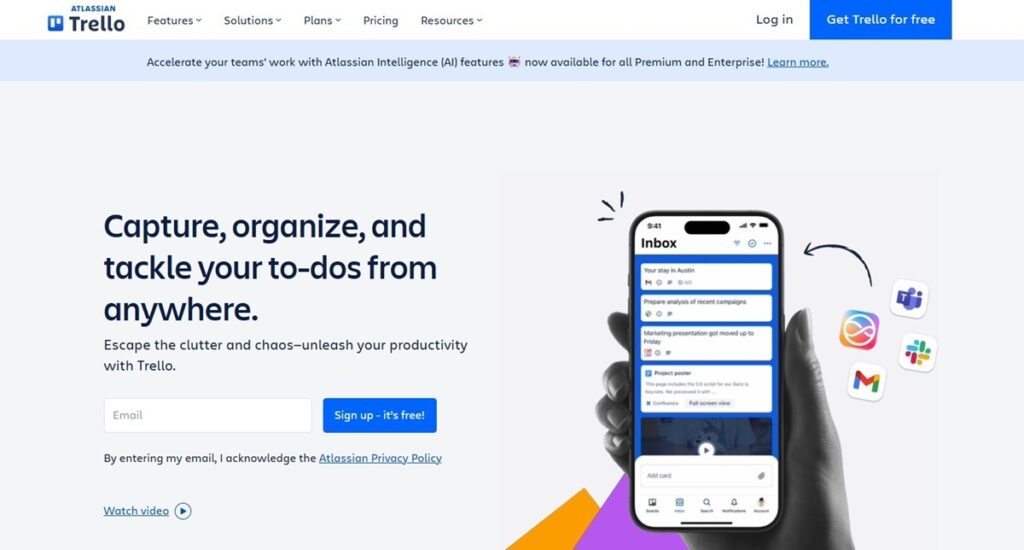
Trello is a digital whiteboard. It uses Kanban boards to show your work. Tasks become cards, moving across lists. This makes project management simple and helps teams work together. Think of smart sticky notes for getting things done with your team.
Why Choose Trello?
Trello stands out. Most tools are too complex. Trello is simple and visual. You see your work, not just a spreadsheet. This makes it easy for your team to start using it right away.
It’s also very flexible. Trello works for any process. Building software, planning a wedding, or tracking sales leads — it fits. It doesn’t tell you how to work. It’s a blank space for your workflow. You can focus on results, not the tool.
Standout Features
Trello’s main parts are its boards, lists, and cards. They create a visual way to manage projects. It’s Butler automation handles repeated tasks. This saves you time. Checklists, due dates, and custom fields keep everything tidy and clear without effort.
Integrations
Trello connects with other apps. Need Slack? Google Drive? Jira? Trello has Power-Ups for that. Your board becomes a central spot. It pulls in what you need from other apps. Your work stays smooth and connected.
Latest Advancements
Trello keeps getting better. New updates add personal productivity tools. An Inbox helps capture tasks from anywhere: emails, Slack, even voice commands. There’s also a Planner. This integrated calendar lets you drag and drop Trello cards to schedule your work. It helps you manage your time without stress. Also, AI features help read messages and pull out details. This makes creating tasks easy.
Pros:
- Very easy to learn and use.
- Shows tasks clearly.
- Flexible for different project types.
Cons:
- It can get messy with too many cards.
- Might not have all the advanced features for big projects.
- Less reporting and data than some competitors.
Pricing
Trello has a free plan. It offers unlimited cards and up to 10 boards per Workspace. Paid plans start at $5 per user each month if you pay yearly.
G2 User Rating – 4.4 out of 5 stars
Conclusion
So, what’s the takeaway? Marketing communication isn’t static. It’s a living thing. It breathes. It changes. The old rules for yelling at people from a billboard? They’re gone. Today, it’s about connection. It’s about being where your audience is. And speaking their language.
The tools are there. The data is waiting. The channels are open. But none of it matters if you don’t have a message worth hearing. A story worth telling. A product that solves a problem.
Your brand’s voice needs to cut through the noise. It needs to be clear. Consistent. And compelling. This isn’t just about selling things. It’s about building relationships. It’s about creating trust. It’s about becoming a signal in a world full of static. Get your message right. The rest follows.
